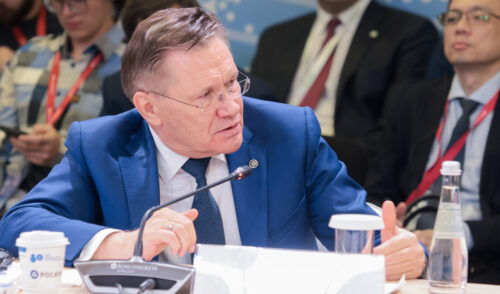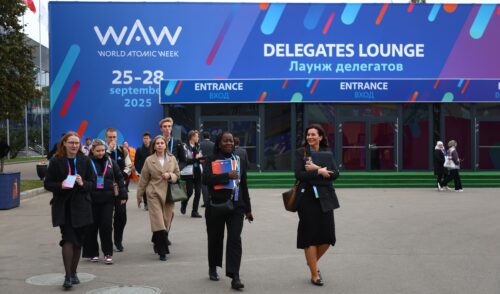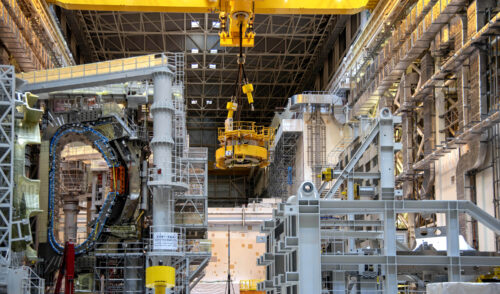
ATOMEXPO 2017 Sets Records
back to contentsThe first day of the forum was devoted to a plenary session of global nuclear leaders who discussed the role of nuclear energy in non-carbon economy. “Mankind is facing two challenges. The first one is availability of electricity. Over two billion people worldwide have restricted access to electric power. The other challenge is nature conservation,” Alexei Likhachev, CEO of Rosatom, noted when speaking at the plenary session. According to him, a third of electricity comes from hydrocarbon sources, which produce more than 13 million tons of CO2 emissions every year. It is clear that the global power industry should reduce emissions. “Renewable sources will make a larger contribution to solving this task than they do today, but they will not be sufficient to both cover peak loads and provide base load power.” It is nuclear energy that should generate base load electricity, he said. “Nuclear power plants are long-term, reliable sources of power. Fuel accounts for less than 10% of nuclear generation costs; the share of natural uranium is even less. This solves three important tasks of establishing a long-term tariff policy, securing return on investment in the existing nuclear plants, and facilitating the prospective development of energy-intensive industries. Along with being environmentally friendly, the nuclear power industry is a kind of insurance policy for national economies.” He noted that nuclear plants outperformed solar farms in terms of capacity utilization.
Rosatom’s CEO also mentioned the Paris Climate Change Agreement. “Certain political developments put the agreement on the agenda again. Two things should be remembered when speaking about its future. The agreement will be effective, and each country will have an opportunity to change the scope of its involvement and forms of participation. The second thing is that the agreement is a truly ‘green’ way of the power industry development till 2050.” He also said that the global target to be achieved by 2050 was to receive 80% of power from non-carbon sources. “It means that installed capacity of nuclear power plants should be increased from 390 GW to 930 GW.” To secure this growth of nuclear generation, satisfy the rising demand for electric power and simultaneously reduce CO2 emissions, large players of the nuclear generation market should join their efforts and work as one to contribute to the common goal, Alexei Likhachev concluded.
Agneta Rising, Director General of the World Nuclear Association, also spoke about the need to develop nuclear energy. “If we look at environment, cost of electricity or security of supply, nuclear energy is the only energy source that ticks all these three boxes at the same time. It is amazing to see that some really intelligent and highly developed countries are going in another direction,” Agneta Rising said. According to her, the global nuclear industry set a target of how much electricity should come from nuclear sources by 2050. “In 2050, the nuclear share should be 25%, and it means building 1000 GW of new capacity by that time. We know only one country that has politically closed its nuclear program. It is Germany. Its ambitious goal is to reduce CO2 emissions while protecting their industry and customers from high electricity prices and keeping Germany competitive. Wind and solar capacity commissioned in the country has exceeded the total nuclear capacity of France. France is the country where nuclear accounts for 75% of electricity generation. They have decarbonized their electricity system. By contrast, Germany has not reduced its CO2 emissions although it has put in operation the same non-carbon capacity. Electricity prices for the industry are the second highest in Europe. This owes a lot to government subsidies for renewables. In the Harmony, we set a target for the global nuclear industry to provide 25% of electricity in the world. It is called ‘harmony’ because we need to harmonize all low-carbon options. All major institutions keep saying that we need nuclear energy.”
It is impossible to stop climate change without nuclear energy, says William Magwood, Director General of the OECD Nuclear Energy Agency. “If we made a firm decision to fight climate change, we cannot go without developing nuclear energy. To meet the COP21 requirements, we have to increase the global nuclear capacity 2.5 times from what we have today,” he said.
Participants of the plenary session were united in the opinion that nuclear should be a reliable source of base load electricity and a basis of low-carbon energy of the future. They agreed that there would be no competition between nuclear energy and renewable sources, such as wind, solar and hydro, in the foreseeable future. “There is no need to look for the opposition between nuclear and renewables as they can work to the same goal,” stressed Daniel Verwaerde, General Administrator of the Alternative Energies and Atomic Energy Commission (France).




